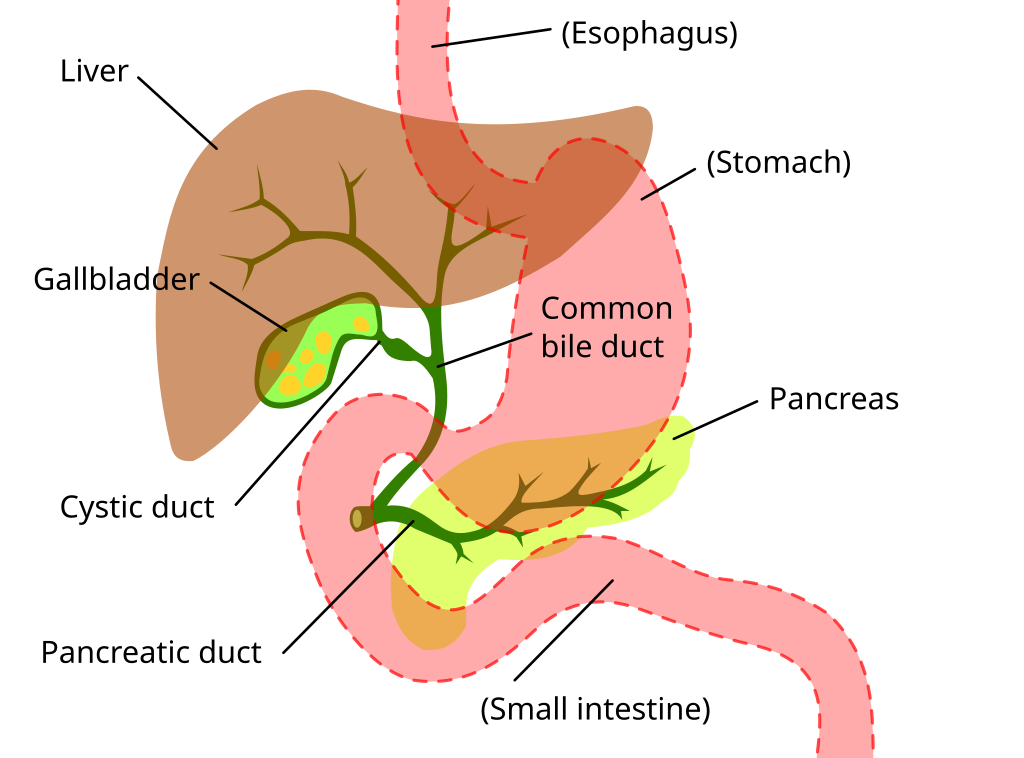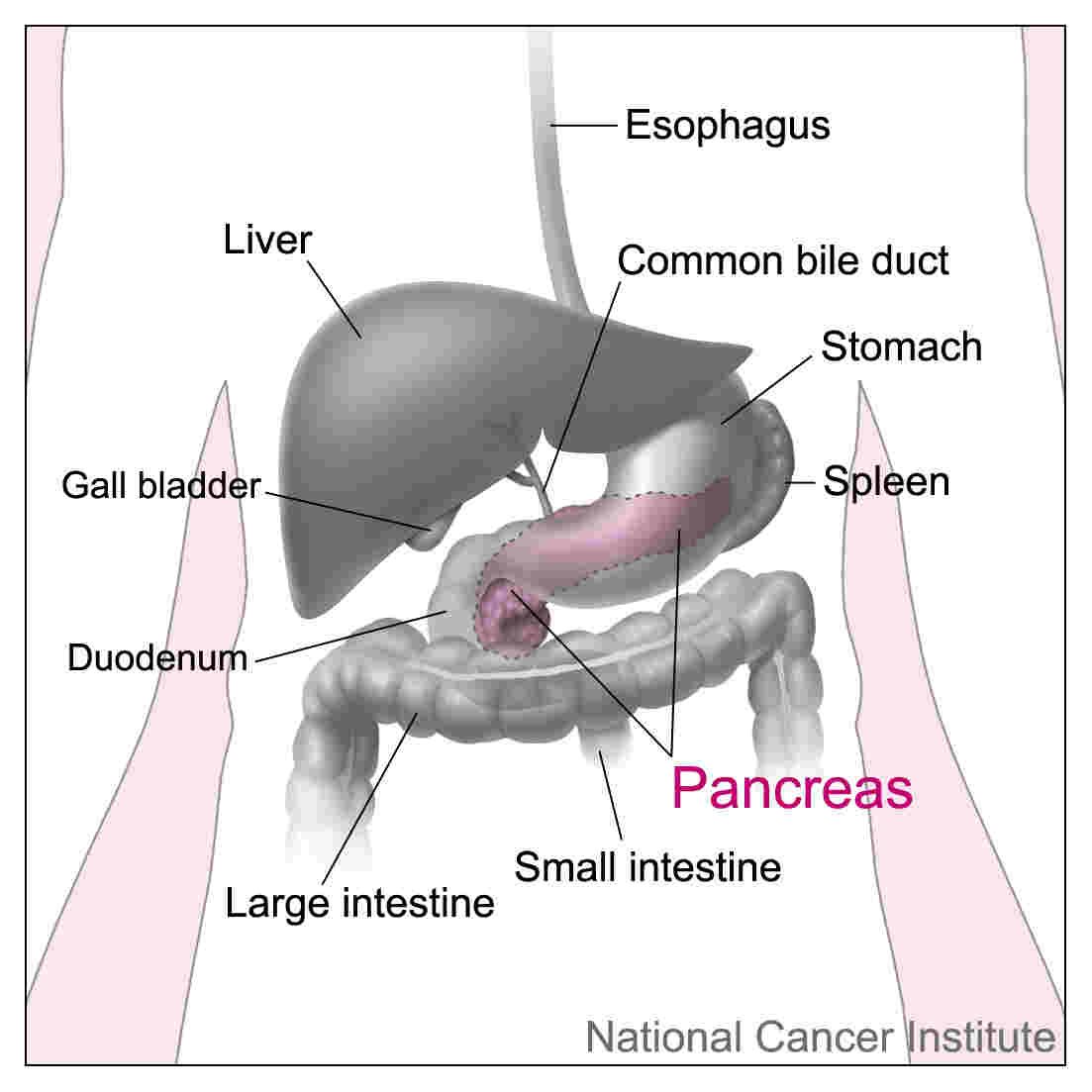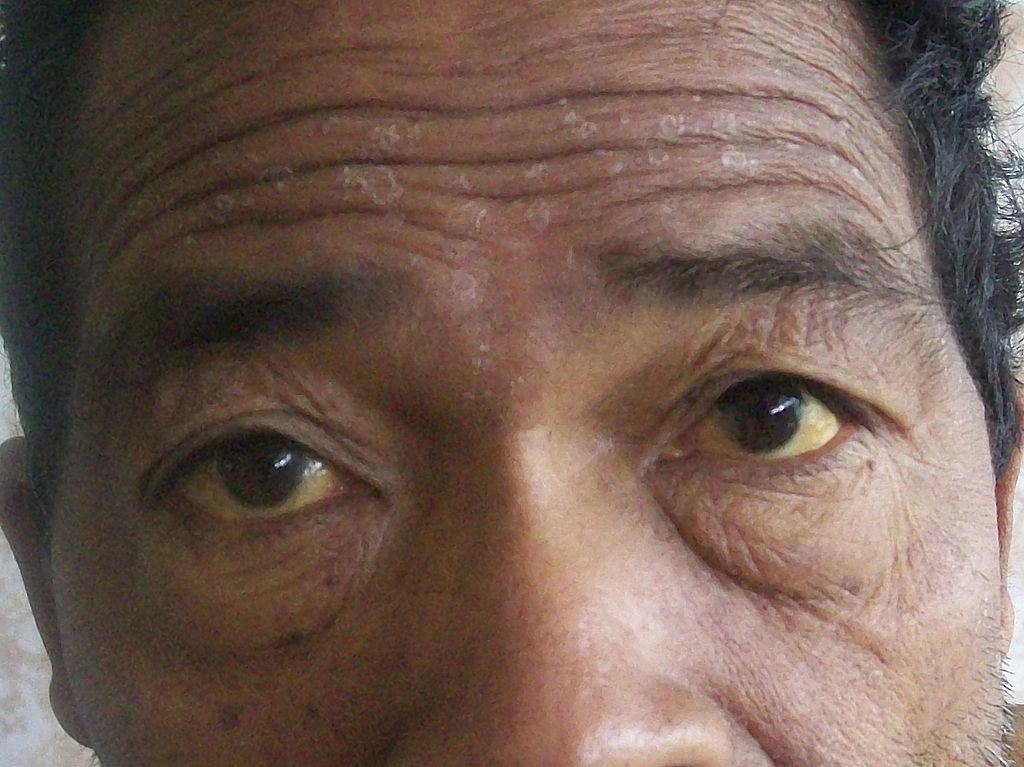Bile Duct Cancer (Cholangiocarcinoma)
Cholangiocarcinoma or bile duct cancer is a malignant tumor developed from the intra or extra hepatic bile ducts or the gallbladder. Bile duct cancer is a rare but serious form of cancer that affects the bile ducts in the liver. It originates from the cells lining the bile ducts, which are responsible for carrying bile from the liver to the small intestine. In this article, we will explore the causes, symptoms, and treatment options for bile duct cancer.

Digestive system diagram showing bile duct location. File:Digestive system showing bile duct.png: Pueblo.gsa.govderivative work: Pixelsquid, Public domain, via Wikimedia Commons
What is a cholangiocarcinoma?
Cholangiocarcinoma is a malignant tumor developed from the intra or extra hepatic bile ducts or the gallbladder. Its frequency is 2 per 100,000 people. Men are slightly more often affected. The average age of onset is around the seventh decade.
The triggering factors of this disease are not well known, certain diseases or congenital anomalies of the bile ducts can promote its occurrence (Caroli’s disease, sclerosing cholangitis, primary or secondary biliary cirrhosis). Certain parasitoses affecting the liver have been implicated.
Symptoms
Bile duct cancer often presents with non-specific symptoms, which can make early detection challenging.
Symptoms are often late (cancer can develop long before giving symptoms) and not very specific (these symptoms can be seen in many other non-tumor diseases).
When the tumor grows it can obstruct the lumen of the bile ducts and trigger jaundice (jaundice). Often it is significant fatigue and weakness, unexplained weight loss, abdominal pain predominantly on the right side associated with an increase in the size of the liver (hepatomegaly) which are the first symptoms.
Yellowing of the skin (jaundice) and eyes (scleral icterus). Bobjgalindo, CC BY-SA 4.0, via Wikimedia Commons
Causes and risk factors
The exact cause of bile duct cancer is still unknown. However, several factors have been associated with an increased risk of developing this condition. These include:
- Primary Sclerosing Cholangitis (PSC): PSC is a chronic liver disease that causes inflammation and scarring of the bile ducts, increasing the risk of bile duct cancer.
- Chronic Liver Diseases: Conditions such as hepatitis B or C, cirrhosis, and non-alcoholic fatty liver disease (NAFLD) can increase the risk of bile duct cancer.
- Bile Duct Abnormalities: Certain congenital abnormalities or structural changes in the bile ducts can predispose individuals to develop bile duct cancer.
- Exposure to Toxins and Environmental Factors: Exposure to certain chemicals or toxins, such as thorotrast (a radioactive contrast agent), may increase the risk of developing bile duct cancer.
Diagnostic
There is no screening test for cholangiocarcinoma. Abdominal ultrasound is the screening examination carried out in first intention. It often makes it possible to highlight a dilation of the bile ducts upstream of the tumor, the presence of a mass, of hepatic secondary localizations. A computed tomography (scanner) is often performed later. This examination makes it possible to better visualize the tumoral process and to look for the possible presence of other tumoral localizations (metastases).
To help the surgeon, it may be proposed to perform Magnetic Resonance Imaging (MRI) to better define the bile ducts invaded by the tumour. Endoscopic ultrasound can be useful to perform a puncture to obtain proof of the disease. This examination requires general anesthesia.
Retrograde papillary catheterization, an endoscopic procedure performed under general anesthesia, involves inserting a tube carrying a camera through the mouth, descending into the esophagus, then the stomach, then the duodenum and placing contrast product in the airways. gallstones. This allows precise mapping of these bile ducts in the event of tumors and possibly during the gesture of brushing which sometimes makes it possible to collect malignant cells, thus confirming the diagnosis of cholangiocarcinoma.
The diagnosis of certainty must indeed be made by reading the tumor cells under the microscope (cytological and/or histological analysis). Obtaining these cells can be done by puncture through the skin, on an operating specimen if surgery, by ultrasound endoscopy or catheterization. Obtaining a sample can be very tricky and difficult in this pathology, sometimes due to localization in the upper bile ducts in infiltrative form without a tumor mass that is really identifiable on imaging.
Treatment
The goal of treatment is to bring about recovery or remission, reduce symptoms, and improve quality of life. It is defined according to the type of cancer, its extension, the general state, the existence of other associated diseases.
Several methods of treatment are used: surgery, chemotherapy, radiotherapy. These different treatments are applied in specialized units. Treatment decisions are made by various specialists involved in the management of cancer during Multidisciplinary Consultation Meetings (MCM).
The basis of treatment is based on surgery, which is the only way to remove all the cancer cells provided that the disease is localized and small in size. Resection is only possible in about 20% of cases. These are most often extensive liver resections with sometimes the need to remove part of the pancreas. These interventions must therefore be discussed by experienced teams of surgeons, radiologists, gastroenterologists and oncologists. Chemotherapy or radiotherapy can sometimes be proposed in addition to surgery.
Cancer Surgery (Operation): Understanding Types, Risks, and Recovery
When the tumor cannot be completely removed, surgery may still be necessary to bypass the digestive tract, or bypass the bile duct which may be obstructed by the tumor and cause jaundice (jaundice). This surgery can sometimes be replaced by the placement of biliary or duodenal prostheses endoscopically under general anesthesia. The freedom of the bile ducts makes it possible to eliminate jaundice and is a prerequisite before starting another anti-tumor treatment such as chemotherapy.
The purpose of chemotherapy is to treat the disease by a chemical effect that destroys the diseased cell by affecting the intimate mechanisms of reproduction cell. These products have the advantage of being distributed through the blood throughout the body, potentially treating all possible locations of the disease.
Chemotherapy Drugs Combinations | Chemo Medications: Understanding Medications for Cancer Treatment
Radiotherapy is still under evaluation. It can be offered as part of a therapeutic clinical research trial.
The treatment also consists of taking care of both physical and psychological pain. If necessary, your doctor can offer the help of teams specialized in this area.
Radiotherapy | Radiation Therapy for Cancer | How Does It Work?
Early detection and timely treatment play a crucial role in improving outcomes. If you or someone you know experiences any symptoms associated with bile duct cancer, it is important to consult a healthcare professional for proper evaluation and diagnosis. They can provide personalized treatment options and support throughout the journey.
Bile Duct cancer survival rate
The survival rate for bile duct cancer, also known as cholangiocarcinoma, can vary depending on several factors, including the stage of the cancer at diagnosis, the location of the tumor, and the overall health of the individual. It’s important to note that survival rates are statistical estimates and cannot predict individual outcomes.
In general, the survival rates for bile duct cancer are relatively low compared to some other types of cancer. According to the American Cancer Society, the overall 5-year survival rate for all stages of bile duct cancer is around 20%. However, it’s important to keep in mind that these statistics can vary based on individual circumstances.
Early detection and treatment play a significant role in improving survival rates for bile duct cancer. Surgical removal of the tumor, when possible, offers the best chance of long-term survival. However, bile duct cancer is often diagnosed at an advanced stage, making it more difficult to treat. In such cases, treatment options may focus on managing symptoms, slowing the progression of the disease, and improving the quality of life.
It’s essential for individuals diagnosed with bile duct cancer to work closely with their healthcare team to develop a personalized treatment plan and to discuss their prognosis. They can provide more accurate and up-to-date information about survival rates based on individual factors and the latest advancements in treatment options. Additionally, seeking support from loved ones and joining support groups can also provide emotional support throughout the journey.
List of all Cancers
The word “cancer” is a generic term for a large group of diseases that can affect any part of the body. We also speak of malignant tumors or neoplasms. One of the hallmarks of cancer is the rapid multiplication of abnormal growing cells, which can invade nearby parts of the body and then migrate to other organs. This is called metastasis, which is the main cause of death from cancer. Types of cancer (in alphabetical order of the area concerned):
Information: Cleverly Smart is not a substitute for a doctor. Always consult a doctor to treat your health condition.
Sources: NHS, PinterPandai, National Cancer Institute (.gov), Johns Hopkins Medicine
Photo credit: Don Bliss (Illustrator), Public domain, via Wikimedia Commons




